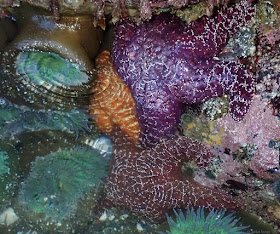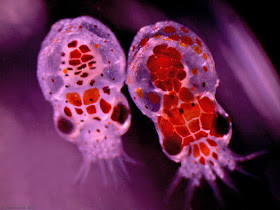After finishing field work on 11 January 2020, we were walking up a trail when I saw this large invertebrate crossing the beam of my headlamp (it was ~8 p.m.):
It was ~6.5 cm (2.5 inches) long, which is sizable for a terrestrial invertebrate in this area.
I didn't know what it was, so I took a few pictures for the record. At home, I did some searching on the Internet to try to figure out what it might be, but I didn't have any luck. It was puzzling that such a striking invertebrate could be so hard to identify.
I thought it might be a beetle larva, but I couldn't find a good match online. The days went by, but the memory of this mystery critter lingered in the back of my mind. I tried online searches several more times, but with the same lack of results. What was it?
Here are close-ups of the head and tail ends:
Last night I decided to submit a picture to BugGuide.Net to see if someone could help with the identification. Not too long after, I received a response that it might be a beetle in the Phengodidae family.
I checked it out and it looks like a good match. More specifically, this is probably a Western Banded Glowworm (Zarhipis integripennis).
I hadn't learned about this species before, but it's a fascinating beetle with a remarkable life history. A few fun facts:
- Yes, they do glow! But just not at the tail end (like a firefly), but at each of the segments, so there are luminous green bands along the back. (Rather than being involved in courtship, the glowing might be defensive, signaling that the glowworms are unpalatable.)
- The adult males look like a fairly typical adult beetle (with very feathery antennae), but the adult females are completely different. The adult females are "larviform," which means they look just like the larvae.
- The larvae are voracious millipede predators. The description of their feeding behavior was almost shocking to me. It read like a lion attack on the Serengeti. It's not for the faint of heart! If you're curious:
"When a Zarhipis larva discovers a milliped, it races alongside the milliped until it can mount its back...When mounted, the larva throws a coil around the milliped with its last abdominal segments and uses the tenth abdominal segment in an opposable manner to aid its grip. It then stretches full length to reach for the most vulnerable part of the milliped's exoskeleton — the articulating membrane (where the main nerve is near the surface) between the head and the first body segment on the ventral side. The larva severs the main nerve with its sickle-shaped mandibles, paralyzing the milliped." (Tiemann 1967)
The glowworm larva then brings the paralyzed millipede underground, eats the head first and then proceeds to tunnel through the body of the millipede eating all of its soft parts and leaving only the hard exoskeleton behind.
We've seen lots of millipedes along the trail we were walking, but I had no idea they are sometimes being chased by glowworm larvae!










































